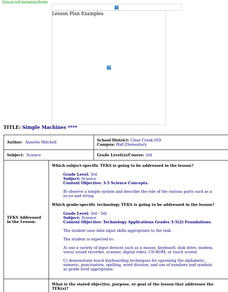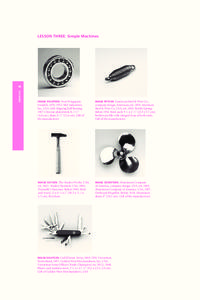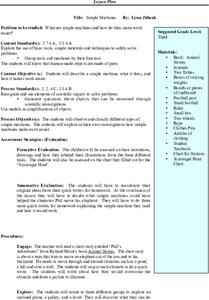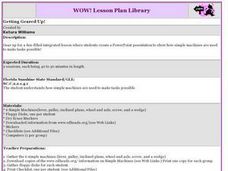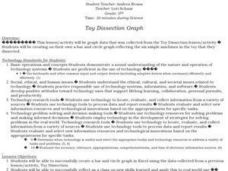Curated OER
Simple Machines
Students investigate and explain simple machines and their uses. Key concepts include: lever, screw, pulley, wheel and axle, inclined plane, and wedge.
Curated OER
Simple Machines - Inclined Plane
Pupils learn the fundamentals and daily applications of simple machines.
Curated OER
Simple Machines - Kid Pix
Third graders recognize simple machines in their environment. They create a picture of his/her simple machine in Kid Pix Studio. Once students have completed their picture have them save it to their desktop or disk. Next they create a...
Curated OER
Simple Machines
Students recognize simple machines in their environment, create a picture of a simple machine using KidPix Software, and appropriately name and identify the type of simple machine that they have created using their keyboard.
Curated OER
Fulcrums in Our Body
Second graders discuss fulcrums and levers and identify at least two fulcrums and levers on their bodies. They also identify fulcrums and levers on animal bodies.
Curated OER
How Can We Move Our Principal?
Students learn about six simple machines. Students use their knowledge of simple machines to build their unique machine. Students write reports explaining their machines.
Museum of Science
Gadget Anatomy: Understanding Machines
Students observe a machine closely from several angles while it operates. Identify the elements of machines combined in different gadgets. Create a clear diagram of how a machine works.
Curated OER
Can You Find the Difference?
Students create their own balance to determine a difference in the weight (and composition) of cents made in different years.
Curated OER
Simple Machines
Pupils define the term simple machine, identify and appreciate their use. In this simple machines instructional activity students complete an activity and share their ideas.
Curated OER
Exploring Levers
Students examine the parts of a lever system and their functions. For this simple machines lesson students study the different classes of levers and what they are used for.
Curated OER
Plane Pretenders
Young scholars examine simple machines evaluating a screw as an inclined plane. In this simple machines instructional activity, students use nuts and bolts and a microscopic vantage point to discover how to find an inclined plane. Young...
Curated OER
Simple Machines
Learners design objects in the Museum of Modern Art's collection of simple machines. In this simple machines lesson, students explore the machine age in the MoMA's design collection. Learners identify simple machines and the elements in...
Curated OER
Machines at Home
In this simple machines worksheet, students examine methods to reduce friction in simple machines and note 5 of them on the lines provided.
Curated OER
Simple Machines Cryptogram
In this simple machines worksheet, students unscramble the words that represent simple machines. Students unscramble 9 words and come up with a secret message in the end.
Curated OER
Simple Machines: Word Scramble Worksheet
In this simple machines word scramble worksheet, students unscramble the letters in 15 words pertaining to simple machines. There is no word list.
Curated OER
Crossword: Simple Machines
In this simple machine worksheet, students read the simple machine definitions and then complete the crossword puzzle for the simple machine terms.
Curated OER
Directions for Making an Inclined Plane
In this simple machines worksheet, students follow the 5 directions and create a model of an inclined plane. Materials needed are a pencil, paper and tape.
Curated OER
Simple Machines
Third graders listen to a short story entitled, "Phil's Adventures" from a book called Animal Stories. They stop at each obstacle in the story and do a quick write about how they would overcome the obstacle and draw a picture to...
Curated OER
The Physics of Tools
Middle schoolers investigate the nature and work of simple tools and mechanics.
They explain how each simple machine can be used in real world applications. They explore levers, balance beams, windlasses, wedges, gears, ocarinas,...
Curated OER
Getting Geared Up!
Learners create their own Power Point presentation displaying clip art pictures of simple machines and telling how each machine makes tasks easier. They break into small groups and review information on simple machines from website and...
Curated OER
Machines: Useful But Dangerous
First graders study, observe, and use a simple machine. They study necessary safety and review posted safety rules related to using a machine and identify strategies for reporting any accidents or injuries.
Curated OER
Simple Machines/Technology
Third graders examine the concept of work as the movement of an object through a distance. They define gravity and determine what type of work is caused by gravity. They measure how far an object is moved by a force. They make a...
Curated OER
Simple Machines
Fifth graders study how simple machines can help us alter forces and discuss the term mechanical advantage. They then identify dysfunctional simple machines and discuss in groups how the dysfunctions will decrease the effectiveness of each.
Curated OER
Toy Dissection Graph
Students explore simple machines and how they are made. They examine the parts of the simple machine and collect information about its parts. Using Excel, students create circle and bar graphs from the collected data.





